Reflection on Organisational Development: EPM, Decision Lens Analysis
VerifiedAdded on 2020/10/22
|8
|2362
|404
Report
AI Summary
This report provides a reflective analysis of organisational development, drawing upon the author's experiences at EPM Technology and Decision Lens. The report explores the application of socio-technical systems, examining how they can be jointly optimized to achieve the best outcomes for an org...
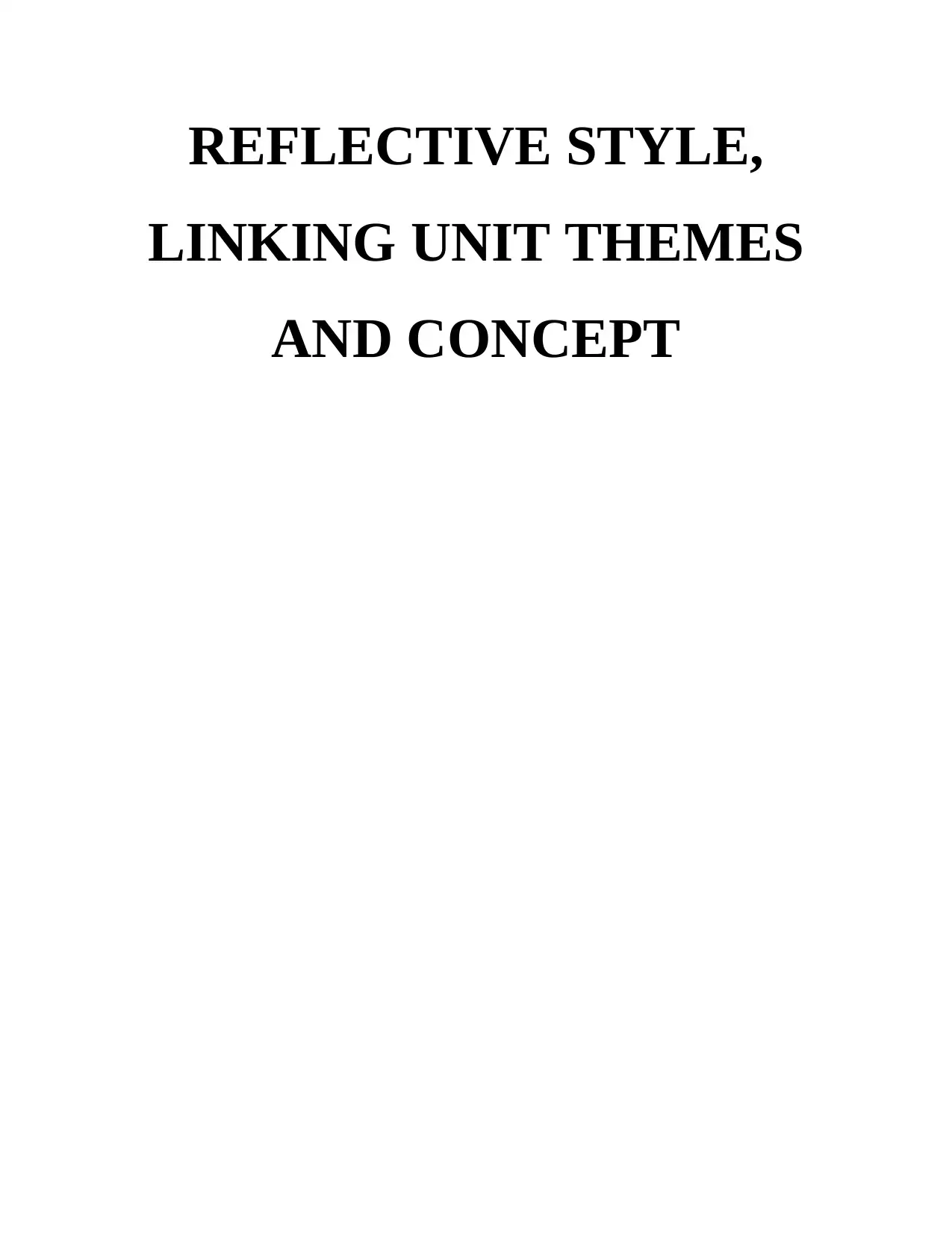
REFLECTIVE STYLE,
LINKING UNIT THEMES
AND CONCEPT
LINKING UNIT THEMES
AND CONCEPT
Secure Best Marks with AI Grader
Need help grading? Try our AI Grader for instant feedback on your assignments.
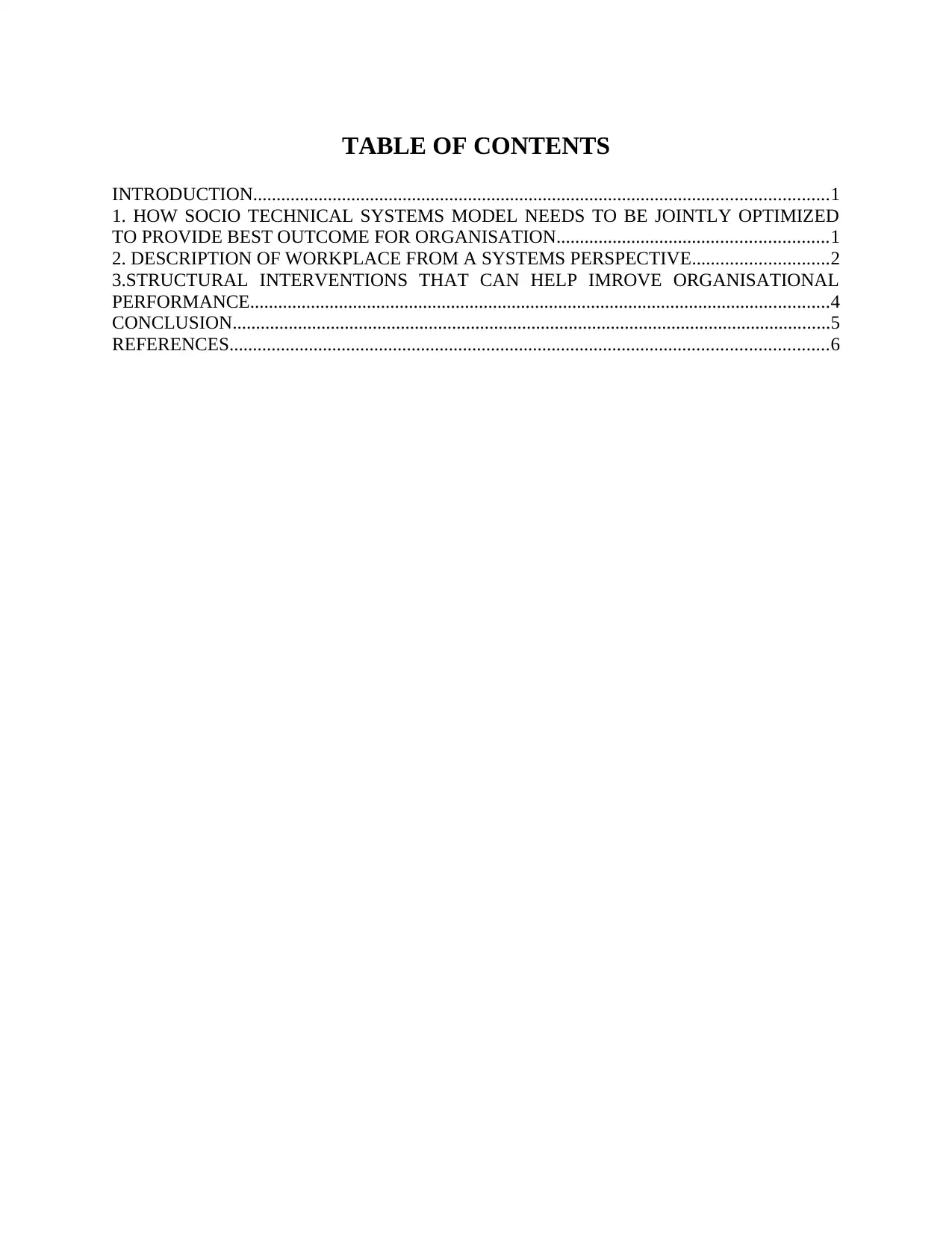
TABLE OF CONTENTS
INTRODUCTION...........................................................................................................................1
1. HOW SOCIO TECHNICAL SYSTEMS MODEL NEEDS TO BE JOINTLY OPTIMIZED
TO PROVIDE BEST OUTCOME FOR ORGANISATION..........................................................1
2. DESCRIPTION OF WORKPLACE FROM A SYSTEMS PERSPECTIVE.............................2
3.STRUCTURAL INTERVENTIONS THAT CAN HELP IMROVE ORGANISATIONAL
PERFORMANCE............................................................................................................................4
CONCLUSION................................................................................................................................5
REFERENCES................................................................................................................................6
INTRODUCTION...........................................................................................................................1
1. HOW SOCIO TECHNICAL SYSTEMS MODEL NEEDS TO BE JOINTLY OPTIMIZED
TO PROVIDE BEST OUTCOME FOR ORGANISATION..........................................................1
2. DESCRIPTION OF WORKPLACE FROM A SYSTEMS PERSPECTIVE.............................2
3.STRUCTURAL INTERVENTIONS THAT CAN HELP IMROVE ORGANISATIONAL
PERFORMANCE............................................................................................................................4
CONCLUSION................................................................................................................................5
REFERENCES................................................................................................................................6
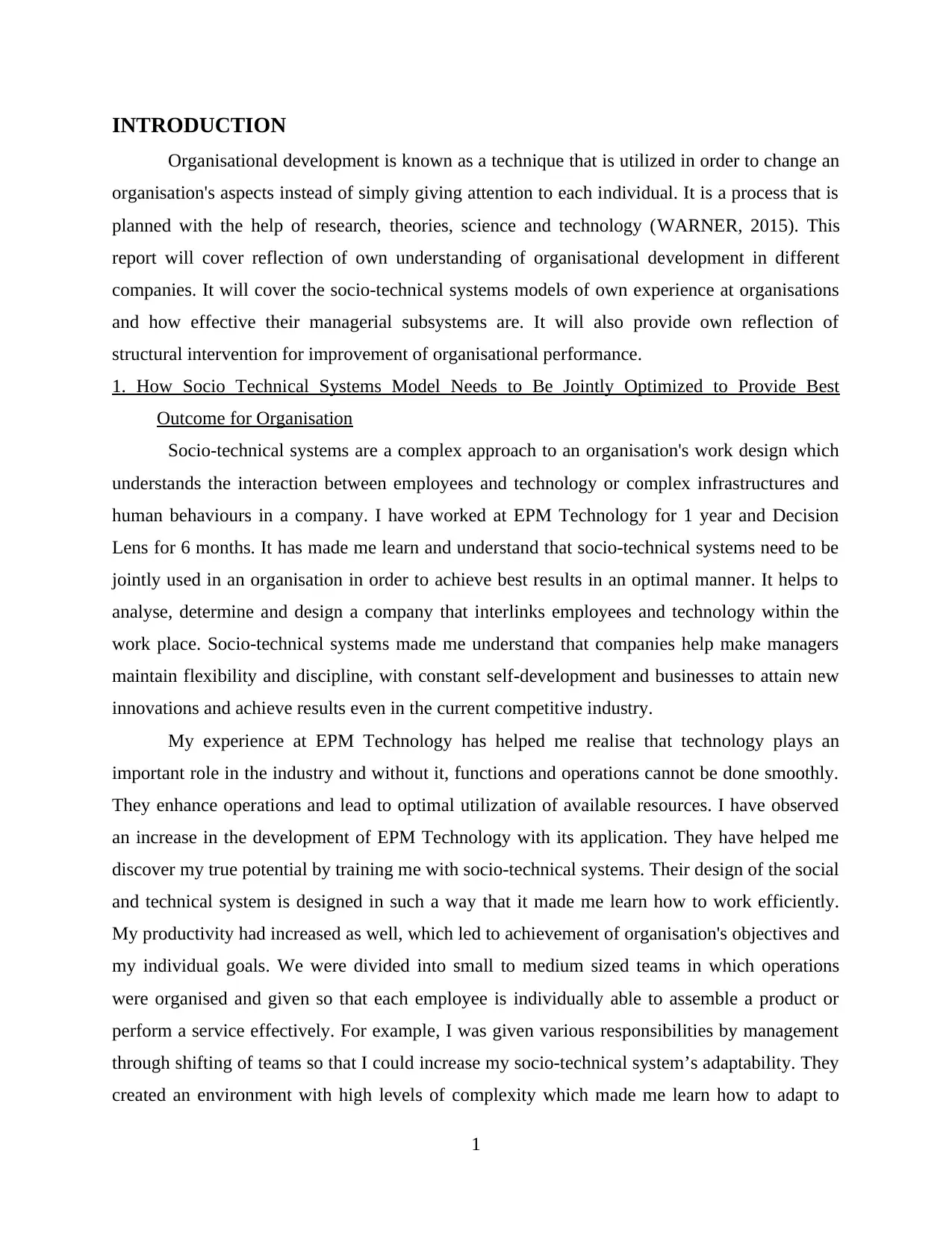
INTRODUCTION
Organisational development is known as a technique that is utilized in order to change an
organisation's aspects instead of simply giving attention to each individual. It is a process that is
planned with the help of research, theories, science and technology (WARNER, 2015). This
report will cover reflection of own understanding of organisational development in different
companies. It will cover the socio-technical systems models of own experience at organisations
and how effective their managerial subsystems are. It will also provide own reflection of
structural intervention for improvement of organisational performance.
1. How Socio Technical Systems Model Needs to Be Jointly Optimized to Provide Best
Outcome for Organisation
Socio-technical systems are a complex approach to an organisation's work design which
understands the interaction between employees and technology or complex infrastructures and
human behaviours in a company. I have worked at EPM Technology for 1 year and Decision
Lens for 6 months. It has made me learn and understand that socio-technical systems need to be
jointly used in an organisation in order to achieve best results in an optimal manner. It helps to
analyse, determine and design a company that interlinks employees and technology within the
work place. Socio-technical systems made me understand that companies help make managers
maintain flexibility and discipline, with constant self-development and businesses to attain new
innovations and achieve results even in the current competitive industry.
My experience at EPM Technology has helped me realise that technology plays an
important role in the industry and without it, functions and operations cannot be done smoothly.
They enhance operations and lead to optimal utilization of available resources. I have observed
an increase in the development of EPM Technology with its application. They have helped me
discover my true potential by training me with socio-technical systems. Their design of the social
and technical system is designed in such a way that it made me learn how to work efficiently.
My productivity had increased as well, which led to achievement of organisation's objectives and
my individual goals. We were divided into small to medium sized teams in which operations
were organised and given so that each employee is individually able to assemble a product or
perform a service effectively. For example, I was given various responsibilities by management
through shifting of teams so that I could increase my socio-technical system’s adaptability. They
created an environment with high levels of complexity which made me learn how to adapt to
1
Organisational development is known as a technique that is utilized in order to change an
organisation's aspects instead of simply giving attention to each individual. It is a process that is
planned with the help of research, theories, science and technology (WARNER, 2015). This
report will cover reflection of own understanding of organisational development in different
companies. It will cover the socio-technical systems models of own experience at organisations
and how effective their managerial subsystems are. It will also provide own reflection of
structural intervention for improvement of organisational performance.
1. How Socio Technical Systems Model Needs to Be Jointly Optimized to Provide Best
Outcome for Organisation
Socio-technical systems are a complex approach to an organisation's work design which
understands the interaction between employees and technology or complex infrastructures and
human behaviours in a company. I have worked at EPM Technology for 1 year and Decision
Lens for 6 months. It has made me learn and understand that socio-technical systems need to be
jointly used in an organisation in order to achieve best results in an optimal manner. It helps to
analyse, determine and design a company that interlinks employees and technology within the
work place. Socio-technical systems made me understand that companies help make managers
maintain flexibility and discipline, with constant self-development and businesses to attain new
innovations and achieve results even in the current competitive industry.
My experience at EPM Technology has helped me realise that technology plays an
important role in the industry and without it, functions and operations cannot be done smoothly.
They enhance operations and lead to optimal utilization of available resources. I have observed
an increase in the development of EPM Technology with its application. They have helped me
discover my true potential by training me with socio-technical systems. Their design of the social
and technical system is designed in such a way that it made me learn how to work efficiently.
My productivity had increased as well, which led to achievement of organisation's objectives and
my individual goals. We were divided into small to medium sized teams in which operations
were organised and given so that each employee is individually able to assemble a product or
perform a service effectively. For example, I was given various responsibilities by management
through shifting of teams so that I could increase my socio-technical system’s adaptability. They
created an environment with high levels of complexity which made me learn how to adapt to
1
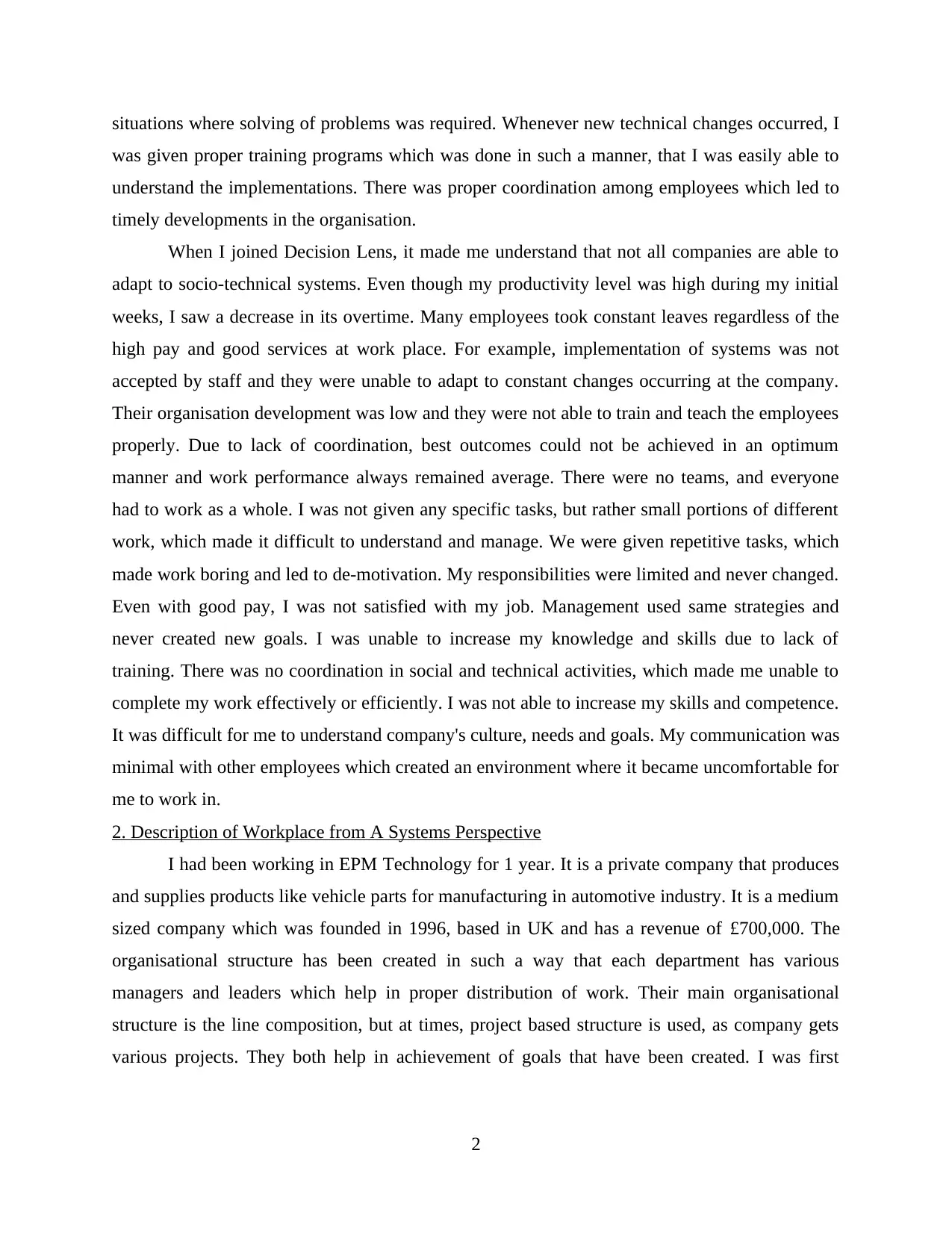
situations where solving of problems was required. Whenever new technical changes occurred, I
was given proper training programs which was done in such a manner, that I was easily able to
understand the implementations. There was proper coordination among employees which led to
timely developments in the organisation.
When I joined Decision Lens, it made me understand that not all companies are able to
adapt to socio-technical systems. Even though my productivity level was high during my initial
weeks, I saw a decrease in its overtime. Many employees took constant leaves regardless of the
high pay and good services at work place. For example, implementation of systems was not
accepted by staff and they were unable to adapt to constant changes occurring at the company.
Their organisation development was low and they were not able to train and teach the employees
properly. Due to lack of coordination, best outcomes could not be achieved in an optimum
manner and work performance always remained average. There were no teams, and everyone
had to work as a whole. I was not given any specific tasks, but rather small portions of different
work, which made it difficult to understand and manage. We were given repetitive tasks, which
made work boring and led to de-motivation. My responsibilities were limited and never changed.
Even with good pay, I was not satisfied with my job. Management used same strategies and
never created new goals. I was unable to increase my knowledge and skills due to lack of
training. There was no coordination in social and technical activities, which made me unable to
complete my work effectively or efficiently. I was not able to increase my skills and competence.
It was difficult for me to understand company's culture, needs and goals. My communication was
minimal with other employees which created an environment where it became uncomfortable for
me to work in.
2. Description of Workplace from A Systems Perspective
I had been working in EPM Technology for 1 year. It is a private company that produces
and supplies products like vehicle parts for manufacturing in automotive industry. It is a medium
sized company which was founded in 1996, based in UK and has a revenue of £700,000. The
organisational structure has been created in such a way that each department has various
managers and leaders which help in proper distribution of work. Their main organisational
structure is the line composition, but at times, project based structure is used, as company gets
various projects. They both help in achievement of goals that have been created. I was first
2
was given proper training programs which was done in such a manner, that I was easily able to
understand the implementations. There was proper coordination among employees which led to
timely developments in the organisation.
When I joined Decision Lens, it made me understand that not all companies are able to
adapt to socio-technical systems. Even though my productivity level was high during my initial
weeks, I saw a decrease in its overtime. Many employees took constant leaves regardless of the
high pay and good services at work place. For example, implementation of systems was not
accepted by staff and they were unable to adapt to constant changes occurring at the company.
Their organisation development was low and they were not able to train and teach the employees
properly. Due to lack of coordination, best outcomes could not be achieved in an optimum
manner and work performance always remained average. There were no teams, and everyone
had to work as a whole. I was not given any specific tasks, but rather small portions of different
work, which made it difficult to understand and manage. We were given repetitive tasks, which
made work boring and led to de-motivation. My responsibilities were limited and never changed.
Even with good pay, I was not satisfied with my job. Management used same strategies and
never created new goals. I was unable to increase my knowledge and skills due to lack of
training. There was no coordination in social and technical activities, which made me unable to
complete my work effectively or efficiently. I was not able to increase my skills and competence.
It was difficult for me to understand company's culture, needs and goals. My communication was
minimal with other employees which created an environment where it became uncomfortable for
me to work in.
2. Description of Workplace from A Systems Perspective
I had been working in EPM Technology for 1 year. It is a private company that produces
and supplies products like vehicle parts for manufacturing in automotive industry. It is a medium
sized company which was founded in 1996, based in UK and has a revenue of £700,000. The
organisational structure has been created in such a way that each department has various
managers and leaders which help in proper distribution of work. Their main organisational
structure is the line composition, but at times, project based structure is used, as company gets
various projects. They both help in achievement of goals that have been created. I was first
2
Secure Best Marks with AI Grader
Need help grading? Try our AI Grader for instant feedback on your assignments.
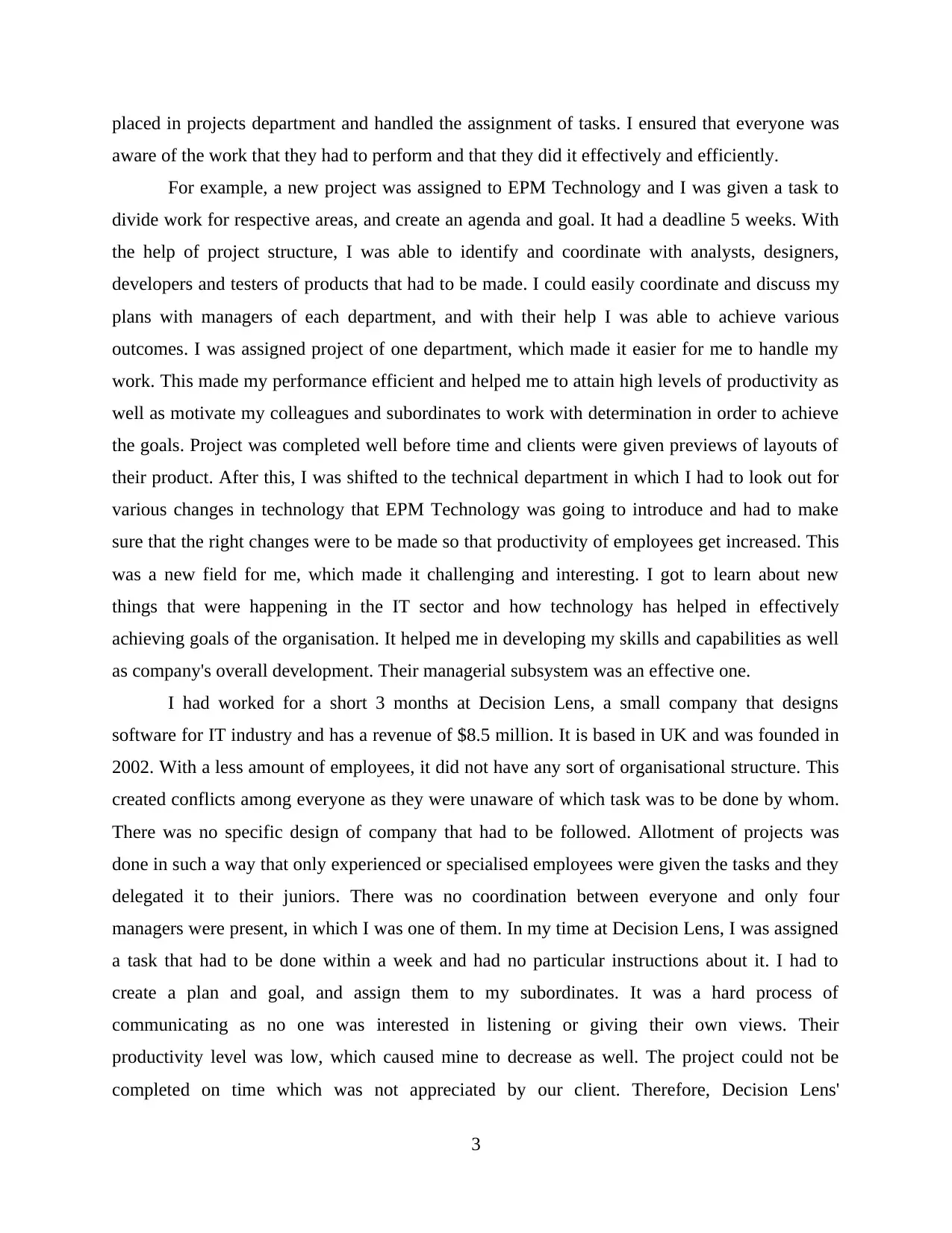
placed in projects department and handled the assignment of tasks. I ensured that everyone was
aware of the work that they had to perform and that they did it effectively and efficiently.
For example, a new project was assigned to EPM Technology and I was given a task to
divide work for respective areas, and create an agenda and goal. It had a deadline 5 weeks. With
the help of project structure, I was able to identify and coordinate with analysts, designers,
developers and testers of products that had to be made. I could easily coordinate and discuss my
plans with managers of each department, and with their help I was able to achieve various
outcomes. I was assigned project of one department, which made it easier for me to handle my
work. This made my performance efficient and helped me to attain high levels of productivity as
well as motivate my colleagues and subordinates to work with determination in order to achieve
the goals. Project was completed well before time and clients were given previews of layouts of
their product. After this, I was shifted to the technical department in which I had to look out for
various changes in technology that EPM Technology was going to introduce and had to make
sure that the right changes were to be made so that productivity of employees get increased. This
was a new field for me, which made it challenging and interesting. I got to learn about new
things that were happening in the IT sector and how technology has helped in effectively
achieving goals of the organisation. It helped me in developing my skills and capabilities as well
as company's overall development. Their managerial subsystem was an effective one.
I had worked for a short 3 months at Decision Lens, a small company that designs
software for IT industry and has a revenue of $8.5 million. It is based in UK and was founded in
2002. With a less amount of employees, it did not have any sort of organisational structure. This
created conflicts among everyone as they were unaware of which task was to be done by whom.
There was no specific design of company that had to be followed. Allotment of projects was
done in such a way that only experienced or specialised employees were given the tasks and they
delegated it to their juniors. There was no coordination between everyone and only four
managers were present, in which I was one of them. In my time at Decision Lens, I was assigned
a task that had to be done within a week and had no particular instructions about it. I had to
create a plan and goal, and assign them to my subordinates. It was a hard process of
communicating as no one was interested in listening or giving their own views. Their
productivity level was low, which caused mine to decrease as well. The project could not be
completed on time which was not appreciated by our client. Therefore, Decision Lens'
3
aware of the work that they had to perform and that they did it effectively and efficiently.
For example, a new project was assigned to EPM Technology and I was given a task to
divide work for respective areas, and create an agenda and goal. It had a deadline 5 weeks. With
the help of project structure, I was able to identify and coordinate with analysts, designers,
developers and testers of products that had to be made. I could easily coordinate and discuss my
plans with managers of each department, and with their help I was able to achieve various
outcomes. I was assigned project of one department, which made it easier for me to handle my
work. This made my performance efficient and helped me to attain high levels of productivity as
well as motivate my colleagues and subordinates to work with determination in order to achieve
the goals. Project was completed well before time and clients were given previews of layouts of
their product. After this, I was shifted to the technical department in which I had to look out for
various changes in technology that EPM Technology was going to introduce and had to make
sure that the right changes were to be made so that productivity of employees get increased. This
was a new field for me, which made it challenging and interesting. I got to learn about new
things that were happening in the IT sector and how technology has helped in effectively
achieving goals of the organisation. It helped me in developing my skills and capabilities as well
as company's overall development. Their managerial subsystem was an effective one.
I had worked for a short 3 months at Decision Lens, a small company that designs
software for IT industry and has a revenue of $8.5 million. It is based in UK and was founded in
2002. With a less amount of employees, it did not have any sort of organisational structure. This
created conflicts among everyone as they were unaware of which task was to be done by whom.
There was no specific design of company that had to be followed. Allotment of projects was
done in such a way that only experienced or specialised employees were given the tasks and they
delegated it to their juniors. There was no coordination between everyone and only four
managers were present, in which I was one of them. In my time at Decision Lens, I was assigned
a task that had to be done within a week and had no particular instructions about it. I had to
create a plan and goal, and assign them to my subordinates. It was a hard process of
communicating as no one was interested in listening or giving their own views. Their
productivity level was low, which caused mine to decrease as well. The project could not be
completed on time which was not appreciated by our client. Therefore, Decision Lens'
3
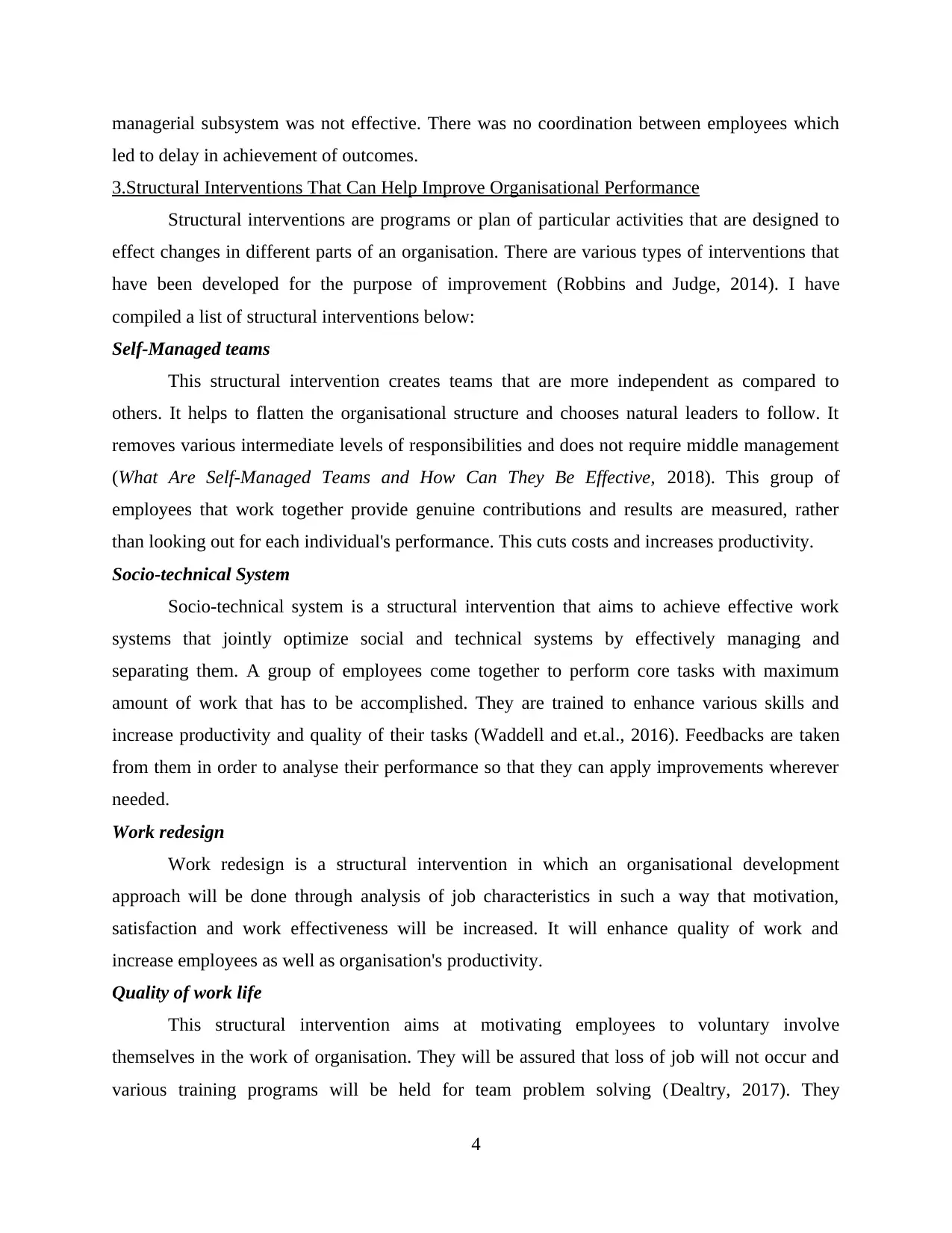
managerial subsystem was not effective. There was no coordination between employees which
led to delay in achievement of outcomes.
3.Structural Interventions That Can Help Improve Organisational Performance
Structural interventions are programs or plan of particular activities that are designed to
effect changes in different parts of an organisation. There are various types of interventions that
have been developed for the purpose of improvement (Robbins and Judge, 2014). I have
compiled a list of structural interventions below:
Self-Managed teams
This structural intervention creates teams that are more independent as compared to
others. It helps to flatten the organisational structure and chooses natural leaders to follow. It
removes various intermediate levels of responsibilities and does not require middle management
(What Are Self-Managed Teams and How Can They Be Effective, 2018). This group of
employees that work together provide genuine contributions and results are measured, rather
than looking out for each individual's performance. This cuts costs and increases productivity.
Socio-technical System
Socio-technical system is a structural intervention that aims to achieve effective work
systems that jointly optimize social and technical systems by effectively managing and
separating them. A group of employees come together to perform core tasks with maximum
amount of work that has to be accomplished. They are trained to enhance various skills and
increase productivity and quality of their tasks (Waddell and et.al., 2016). Feedbacks are taken
from them in order to analyse their performance so that they can apply improvements wherever
needed.
Work redesign
Work redesign is a structural intervention in which an organisational development
approach will be done through analysis of job characteristics in such a way that motivation,
satisfaction and work effectiveness will be increased. It will enhance quality of work and
increase employees as well as organisation's productivity.
Quality of work life
This structural intervention aims at motivating employees to voluntary involve
themselves in the work of organisation. They will be assured that loss of job will not occur and
various training programs will be held for team problem solving (Dealtry, 2017). They
4
led to delay in achievement of outcomes.
3.Structural Interventions That Can Help Improve Organisational Performance
Structural interventions are programs or plan of particular activities that are designed to
effect changes in different parts of an organisation. There are various types of interventions that
have been developed for the purpose of improvement (Robbins and Judge, 2014). I have
compiled a list of structural interventions below:
Self-Managed teams
This structural intervention creates teams that are more independent as compared to
others. It helps to flatten the organisational structure and chooses natural leaders to follow. It
removes various intermediate levels of responsibilities and does not require middle management
(What Are Self-Managed Teams and How Can They Be Effective, 2018). This group of
employees that work together provide genuine contributions and results are measured, rather
than looking out for each individual's performance. This cuts costs and increases productivity.
Socio-technical System
Socio-technical system is a structural intervention that aims to achieve effective work
systems that jointly optimize social and technical systems by effectively managing and
separating them. A group of employees come together to perform core tasks with maximum
amount of work that has to be accomplished. They are trained to enhance various skills and
increase productivity and quality of their tasks (Waddell and et.al., 2016). Feedbacks are taken
from them in order to analyse their performance so that they can apply improvements wherever
needed.
Work redesign
Work redesign is a structural intervention in which an organisational development
approach will be done through analysis of job characteristics in such a way that motivation,
satisfaction and work effectiveness will be increased. It will enhance quality of work and
increase employees as well as organisation's productivity.
Quality of work life
This structural intervention aims at motivating employees to voluntary involve
themselves in the work of organisation. They will be assured that loss of job will not occur and
various training programs will be held for team problem solving (Dealtry, 2017). They
4
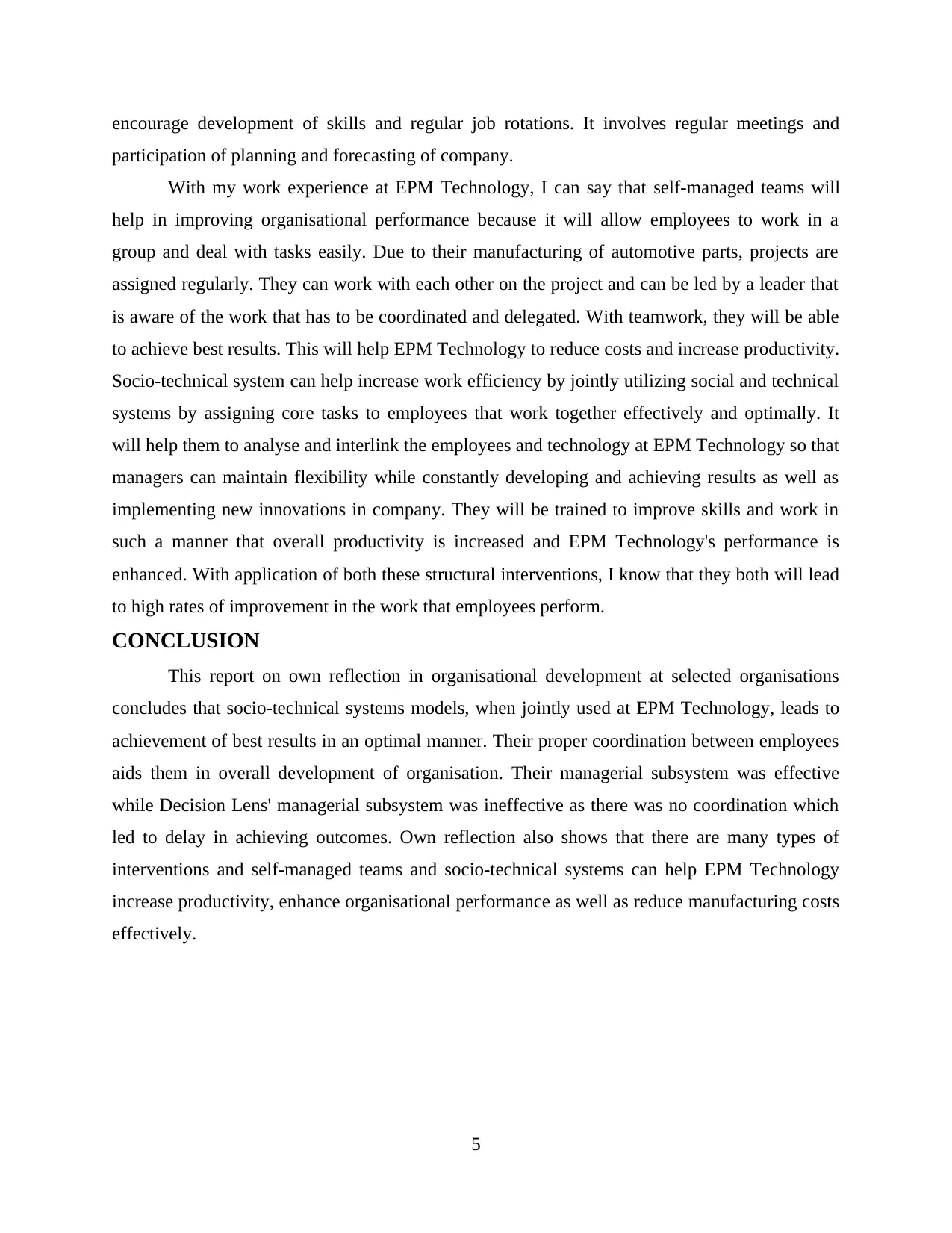
encourage development of skills and regular job rotations. It involves regular meetings and
participation of planning and forecasting of company.
With my work experience at EPM Technology, I can say that self-managed teams will
help in improving organisational performance because it will allow employees to work in a
group and deal with tasks easily. Due to their manufacturing of automotive parts, projects are
assigned regularly. They can work with each other on the project and can be led by a leader that
is aware of the work that has to be coordinated and delegated. With teamwork, they will be able
to achieve best results. This will help EPM Technology to reduce costs and increase productivity.
Socio-technical system can help increase work efficiency by jointly utilizing social and technical
systems by assigning core tasks to employees that work together effectively and optimally. It
will help them to analyse and interlink the employees and technology at EPM Technology so that
managers can maintain flexibility while constantly developing and achieving results as well as
implementing new innovations in company. They will be trained to improve skills and work in
such a manner that overall productivity is increased and EPM Technology's performance is
enhanced. With application of both these structural interventions, I know that they both will lead
to high rates of improvement in the work that employees perform.
CONCLUSION
This report on own reflection in organisational development at selected organisations
concludes that socio-technical systems models, when jointly used at EPM Technology, leads to
achievement of best results in an optimal manner. Their proper coordination between employees
aids them in overall development of organisation. Their managerial subsystem was effective
while Decision Lens' managerial subsystem was ineffective as there was no coordination which
led to delay in achieving outcomes. Own reflection also shows that there are many types of
interventions and self-managed teams and socio-technical systems can help EPM Technology
increase productivity, enhance organisational performance as well as reduce manufacturing costs
effectively.
5
participation of planning and forecasting of company.
With my work experience at EPM Technology, I can say that self-managed teams will
help in improving organisational performance because it will allow employees to work in a
group and deal with tasks easily. Due to their manufacturing of automotive parts, projects are
assigned regularly. They can work with each other on the project and can be led by a leader that
is aware of the work that has to be coordinated and delegated. With teamwork, they will be able
to achieve best results. This will help EPM Technology to reduce costs and increase productivity.
Socio-technical system can help increase work efficiency by jointly utilizing social and technical
systems by assigning core tasks to employees that work together effectively and optimally. It
will help them to analyse and interlink the employees and technology at EPM Technology so that
managers can maintain flexibility while constantly developing and achieving results as well as
implementing new innovations in company. They will be trained to improve skills and work in
such a manner that overall productivity is increased and EPM Technology's performance is
enhanced. With application of both these structural interventions, I know that they both will lead
to high rates of improvement in the work that employees perform.
CONCLUSION
This report on own reflection in organisational development at selected organisations
concludes that socio-technical systems models, when jointly used at EPM Technology, leads to
achievement of best results in an optimal manner. Their proper coordination between employees
aids them in overall development of organisation. Their managerial subsystem was effective
while Decision Lens' managerial subsystem was ineffective as there was no coordination which
led to delay in achieving outcomes. Own reflection also shows that there are many types of
interventions and self-managed teams and socio-technical systems can help EPM Technology
increase productivity, enhance organisational performance as well as reduce manufacturing costs
effectively.
5
Paraphrase This Document
Need a fresh take? Get an instant paraphrase of this document with our AI Paraphraser
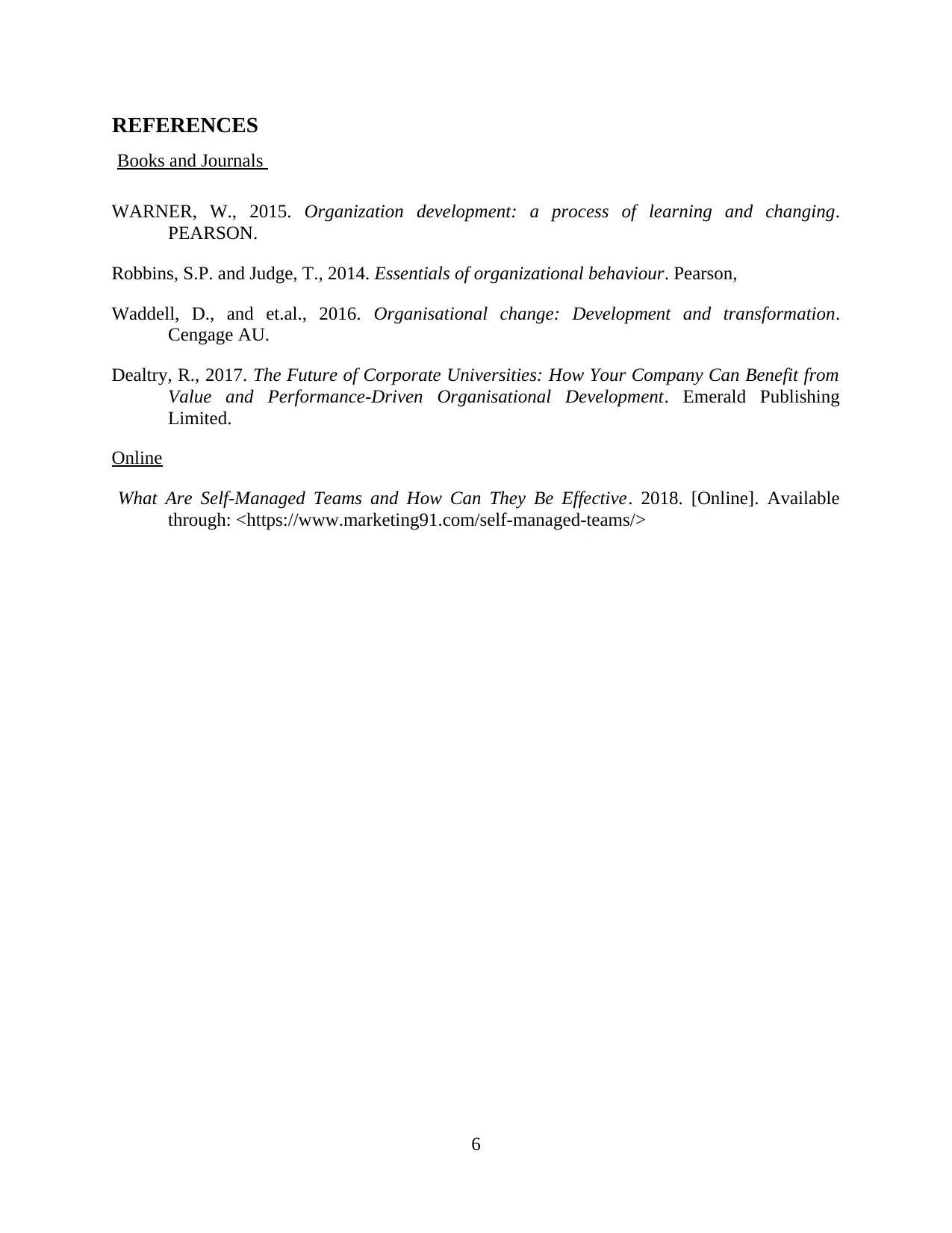
REFERENCES
Books and Journals
WARNER, W., 2015. Organization development: a process of learning and changing.
PEARSON.
Robbins, S.P. and Judge, T., 2014. Essentials of organizational behaviour. Pearson,
Waddell, D., and et.al., 2016. Organisational change: Development and transformation.
Cengage AU.
Dealtry, R., 2017. The Future of Corporate Universities: How Your Company Can Benefit from
Value and Performance-Driven Organisational Development. Emerald Publishing
Limited.
Online
What Are Self-Managed Teams and How Can They Be Effective. 2018. [Online]. Available
through: <https://www.marketing91.com/self-managed-teams/>
6
Books and Journals
WARNER, W., 2015. Organization development: a process of learning and changing.
PEARSON.
Robbins, S.P. and Judge, T., 2014. Essentials of organizational behaviour. Pearson,
Waddell, D., and et.al., 2016. Organisational change: Development and transformation.
Cengage AU.
Dealtry, R., 2017. The Future of Corporate Universities: How Your Company Can Benefit from
Value and Performance-Driven Organisational Development. Emerald Publishing
Limited.
Online
What Are Self-Managed Teams and How Can They Be Effective. 2018. [Online]. Available
through: <https://www.marketing91.com/self-managed-teams/>
6
1 out of 8
Related Documents
Your All-in-One AI-Powered Toolkit for Academic Success.
+13062052269
info@desklib.com
Available 24*7 on WhatsApp / Email
![[object Object]](/_next/static/media/star-bottom.7253800d.svg)
Unlock your academic potential
© 2024 | Zucol Services PVT LTD | All rights reserved.





